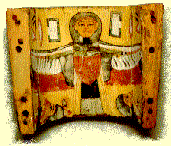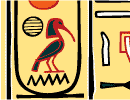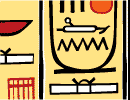Funerary Customs

 Much of our knowledge
about ancient Egyptian culture comes from archaeological evidence
uncovered in tombs. Objects, inscriptions, and paintings from tombs
have led Egyptologists to conclude that what appeared to be a
preoccupation with death was in actuality an overwhelming desire to secure
and perpetuate in the afterlife the "good life" enjoyed on earth.
Much of our knowledge
about ancient Egyptian culture comes from archaeological evidence
uncovered in tombs. Objects, inscriptions, and paintings from tombs
have led Egyptologists to conclude that what appeared to be a
preoccupation with death was in actuality an overwhelming desire to secure
and perpetuate in the afterlife the "good life" enjoyed on earth.
Over the more than three thousand years of ancient Egypt's history,
traditional beliefs about the transition to eternal life persisted, with
new ideas being incorporated from time to time.  Most important for full participation in the afterlife was the need for an
individual's identity to be preserved. Consequently, the body had to
remain intact and receive regular offerings of food and drink.
Most important for full participation in the afterlife was the need for an
individual's identity to be preserved. Consequently, the body had to
remain intact and receive regular offerings of food and drink.
The afterlife was assured by (1) preserving
the body through mummification;
(2) protecting the body in a tomb in which the name of the deceased was
inscribed; and (3) providing the deceased with food and drink or
illustrations of it in case no one was available to make the offerings.
 To protect the spirit of
the deceased, scenes and inscriptions were written on coffins and the
walls of tombs. These texts included such writings as adaptations of
the myth about the death of Osiris and spells to protect the deceased on
his or her dangerous journey to the underworld. Figures known as shabtis
functioned as servants for the deceased.
To protect the spirit of
the deceased, scenes and inscriptions were written on coffins and the
walls of tombs. These texts included such writings as adaptations of
the myth about the death of Osiris and spells to protect the deceased on
his or her dangerous journey to the underworld. Figures known as shabtis
functioned as servants for the deceased.
The final step in the transition to the afterlife was  the judgment by Osiris, god of the underworld, in a ritual known as the Weighing of the
Heart. If a person had led a decent life, he or she would be
judged worthy of eternal life. Many spells and rituals were designed to
ensure a favorable judgment and were written in the papyrus or linen "Book
of the Dead."
the judgment by Osiris, god of the underworld, in a ritual known as the Weighing of the
Heart. If a person had led a decent life, he or she would be
judged worthy of eternal life. Many spells and rituals were designed to
ensure a favorable judgment and were written in the papyrus or linen "Book
of the Dead."
All ancient Egyptians believed in the afterlife and spent their
lives preparing for it. Pharaohs built the finest tombs,
collected the most elaborate funerary equipment, and were mummified in the
most expensive way. Others were able to provide for their afterlives
according to their earthly means. Regardless of their wealth, however,
they all expected the afterlife to be an idealized version of their
earthly existence.





